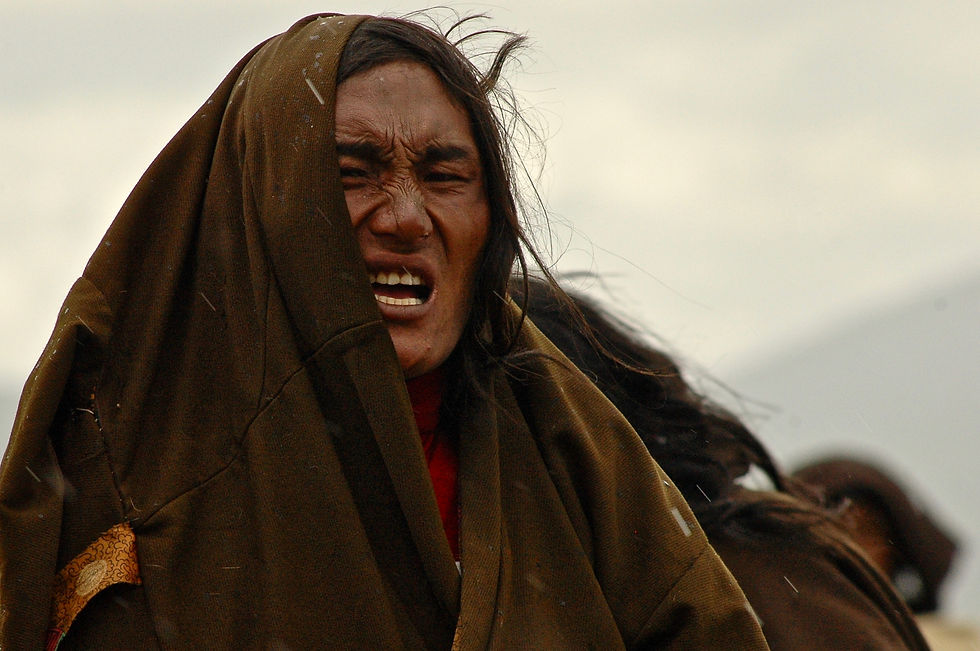Yaks, Creases and Nomads
- Jeff Fuchs
- Jul 31, 2011
- 4 min read

The calm force that is Songjem
The man we pick up in Nyimalung has the calm eyes and weathered face that the mountains create and sculpt almost at will. Songjem is in his early sixties and his face and countenance have a lived in quality that seem universally recognized; appreciated for what it shows. We head south towards Gansu’s border with Sichuan. Somjem is one of those absolute necessities in any travels in this part of the world – a one-man source of tales, geography and of that rare quality in the modern rush, calm.

More of a collection point town than a 'city', Maqu's bulk can be found along two main streets
He will be our informal guide to the Maqu area, where we are headed. Maqu has yak, goat and sheep in quantities that almost nullify the landscapes…it also has nomads that have long lived amidst the rolling hills. Our old friend, the Yellow River (Ma Chu to the locals) coils its muscular way east acting as an accidental guide to our own wanderings.

To Michael and I, the Yellow River, to the Han Chinese the Huang He, and to the Tibetans the Ma Chu (Peacock River). Whatever its name, its presence and influence were always with us
Maqu is yet another crucible – a town that now sits where two main roads collide. No trees interrupt the horizons; and there are many horizons cut by the hills and mountains. While travel along the main road takes time, once we hit the dirt tracks south of Maqu – which access the nomadic bases – we are lucky to hit a top speed of 10 km’s per hour. Valleys are little nations of nomadic communities with the telltale black tents and sprays of black herds of the precious sok (yak).

Fold upon fold, layer upon layer
Here, there are the dual forces of magnificent green highlands contrasting with rampaging winds which take sand from nearby sand dunes and hurl them to every point of the compass. Along the dirt tracks nomads fly upon their motorcycles with a reckless competence that inevitably brings an admiration. At one point a dozen motorbikes partially block the road. Our little group stops to take in one of the Plateau’s great annual ‘harvests’ – sheep wool. No electric clippers here, no pens to steady the flapping bodies, just an ancient aptitude with the hands and a strategy that is fool-proof. Men and young boys fly around with yips and yells corralling the sheep with a long strip of white canvas which is set up to create a three sided box. One by one the agile sheep are grabbed by a hind leg and dragged (and in many hysterical cases drag their ‘draggers’) out to be bound by foot in mere seconds. This done, one of four seniors in the group wields a spectacularly massive pair of scissors and relieve the sheep of their rangy coat. At one point a young boy insists on displaying some of the native skills, which make the nomads revered as pastoralists and ‘hardmen’ of the mountains. No more than six years old, he, with his lean and toughened little body, attempts to grab the hind leg of an equally youthful sheep only to receive a flaying hoof that takes the little boy in the mid-section with a lightning thump. There is a huge roar of approval from his peers urging a continuation of the festivities.

A nomadic boy tries his hand at rustling
More than a match for the little boy the young sheep has the kind of desperate power that makes prey far dangerous than one might imagine. The boy’s clothing and expressions are running the full gamut of colour and dirt until finally (with some very needed help from his colleagues) he manages a vice grip on the sheep only to discover that even with three free legs animal is simply too agile and high strung to ‘take’. Here in this region, this tradition of wool harvesting takes place once a year and as with much in the lives of the drok’pa (nomads) work is injected with a communal sense of unity and fun. IMG_1658_2.jpg – Our arrival to a great valley hemmed in on all sides and to Songjem’s clan and their enormous herds of yak The language flying around is the nomadic dialect that rings with intonations and nasal grunts – the lingua franca of the spaces beyond cities up ‘on high’. Simultaneously brash and vulnerable the nomads take life by the literal and figurative horns and live it intensely; there is no other way at over 4 km’s in the sky. Almost four hours later we arrive to Somjem’s clan and their sprawling valley summer abode of streams and insulating mountain peace. There is the clasp of hands and the kind of non-fussy joy of a genuinely happy reunion. Somjem, like so many of nomads I’ve met doesn’t make introductions immediately; he is taken with his own pleasure and that of his clan. IMG_1650.jpg – Valleys lead into other valleys, which in turn lead to smaller valleys and pockets, and each one resides a nomadic community for the extent of the summer We are almost immediately served up thick and potent ‘sho’ – the thick curd like yoghurt offered up (and taken) in heaps. The tang grips and almost stings the tongue. Like everything on the homestead, it is fresh. We sit around a stove that gives of the acrid almost narcotic waft of yak dung burning.




Comments